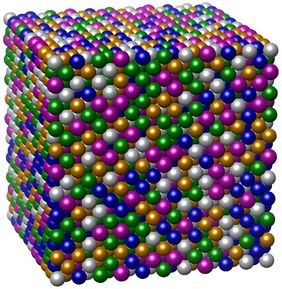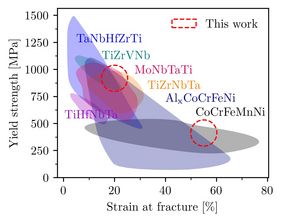High entropy alloys (HEA) are a group of novel metallic materials with outstanding mechanical and functional properties and great potential for future applications, particularly for aerospace, energy and toolmaking industry. The HEAs are alloys consisting of several alloying elements with equal or relatively large proportions of typically five or more elements. This mixture of alloying elements at atomistic level provides the high strength of this material class.
Environmental and economic challenges require fast development cycles for improved materials. At the same time, design of new alloys is a difficult endeavor because of a large number of possible variable parameters, such as a chemical composition. The task can be greatly simplified if one makes use of predictive ab initio methods to relate these parameters to resulting properties. However, the application of such methods to disordered alloys is not easy and requires a high level of expertise. To facilitate the application of cutting-edge simulation methods, MCL developed a prototype of a software toolkit implementing complex workflows for computing important alloy properties. E.g., the solid solution strengthening represents a significant contribution to the total strength of a metallic alloy and the ductility index characterizes the ability of materials to deform without breaking. Although normally such calculations are associated with extreme computational expenses, we employ recently developed models relying strictly only on parameters that can be obtained from ab initio calculations, thereby dramatically reducing the expenses. The whole framework was tested on iron-group (FeMnCoNiCr) as well as refractory (MoNbTiTa) multi-component alloys. Also, direct large-scale simulations of impurity effects on ductility of iron were performed using the facilities of the Oak Ridge National Laboratory, USA, as part of the research stay of the PhD student, Franco Moitzi. The results demonstrated a very good agreement with available experimental data for these alloys, proving the reliability of the underlying methodology.
Impact and effects
The unique combination of simulation methods integrated into a single software package can provide materials designers with a toolkit allowing them to explore a large space of alloy compositions and to find alloy materials optimized simultaneously with respect to strength, ductility, and other properties. In the next step, the ADAMANT toolkit will be equipped with a user-friendly interface, in order to make it a tool bridging the gap between experts in alloy simulations and material scientists who are interested in boosting their design practices by employing predictive modeling.
-
Project coordination
Dr. Oleg Peil
Senior Scientist
Computational Materials Design
Materials Center Leoben Forschung GmbH
T +43 (0) 3842 45922-45
IC-MPPE / COMET-Zentrum
Materials Center Leoben Forschung GmbH
Roseggerstrasse 12
8700 Leoben
T +43 (0) 3842 45922-0
mclburo@mcl.at
www.mcl.at
Projekt partner
• none




















